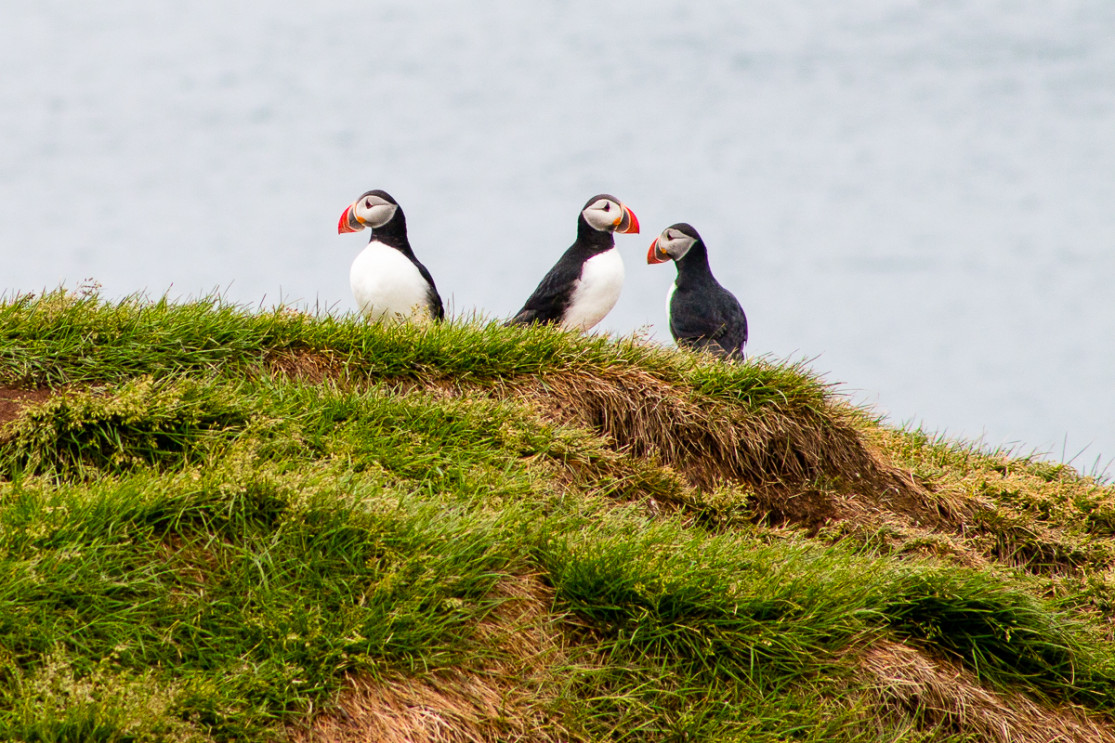Puffins in iceland
Puffins, known as "lundì" in Icelandic, travel to Iceland by the millions every year on their migratory route, so much so that this little bird has become the national symbol. The Atlantic puffin is a creature of modest size, since it measures about 30 cm and has a wingspan of only 60 cm.
Known as the “clown bird”, the puffin has a very peculiar look with its round body, fiery red beak, and black and white feathers. It's a striking look compared to other birds in Iceland. Its flight pattern, it is also fairly easy to recognize because it beats those little wings very quickly.
What are puffins?

The Atlantic puffin is great at its job: fishing. In fact, the colony's whole migratory route is based on the presence of their favourite fish in the local waters (herring, squid, and crustaceans in particular).
This capable seabird can dive for up to a minute to catch several fish at once and swim back to surface with them all in its beak.
It systematically nests near cliffs, choosing places that are often difficult to access to predators.
This adorable little bird has truly chosen Iceland as its favorite country, as since no less than 60% of the world's population of puffins inhabit Iceland (about 6 million).
When and how to observe puffins

Puffins come in large numbers, but they only come during a short period of the year: between June and August.
In August, they leave for warmer countries in the south before returning to Iceland during the summer breeding season. Generally, as early as mid-August, they start to leave the island and become more and more difficult to find.
Puffins are not necessarily fearful, and you can even get quite close to them, sometimes no more than 1 meter away. When they nest, they are easy to approach and photograph, but taking pictures of them in flight is another story, as you can imagine.
It is easy to approach, but that doesn't mean you should. It is important to respect this animal as it is considered an endangered species by the International Union for Conservation of Nature (IUCN) because their population is in decline.
Whatever you do, never touch them or try to give them food. Furthermore, you need to be quiet as these are wild birds, sensitive to noise and prone to panic, and one can trigger the whole colony to panic which is obviously unsafe.
In a cruel twist of fate, you are more likely to see puffins up close when the weather is rainy and overcast... When the sun is out, puffins prefer to fish out at sea where you can't follow them.
Where do puffins nest in Iceland?
Puffins are creatures of habit, and you won't find them all over the island as you would with terns or oystercatchers. Puffin colonies are found in specific locations every year, so here are a few select spots where you are almost certain to spot them between June and August.
In southern Iceland, 3 spots are well known for hosting large puffin colonies: the Dyrholaey arch near Vik; Reynisfjall above Vik; and the Westman islands or more specifically on Heimaey where puffins can be seen near the cliffs and the Stórhöfði lighthouse.
It is also possible to observe them via boat tours that often combines with ice cave visits. Finally, Ingólfshöfði is also an excellent spot near Skaftafell where a tractor trip across the black sands leads to a nice hike to observe a puffin nesting ground.
In the east of Iceland Papey island is very famous, but it is probably in Borgarfjörður Eystri that they will be the easiest to find: near the port are a great number of puffins nests.
A little further north, you will be sure to see them in Raudanes when you hike to Raudanes point. Generally in the north they are more difficult to reach, requiring a boat to the island of Grimsey or Drangey where they come in huge colonies.
There are inland nesting grounds too, such as the Tjornes Peninsula, which has a good number of cliffs home to many of the clown birds.
Near the capital Reykjavík in Faxaflói Bay, they can also be found on the islands of Lundey and Akurey. There are also many of them on Lundey (more than 30,000) and many boating trips from Reykjavík to observe puffins out at sea or even to observe both puffins and whales!
In the west, it is possible to observe them off the coast of Breidafjordur. But if there were only one place in Iceland to see them, it would be Latrabjarg in the northwestern fjords. The true “capital” of the puffin is home to the largest puffin colony, a dramatic site at the top of the cliffs well worth a visit.
Top article photo credit: Agorastosphotography @fotolia